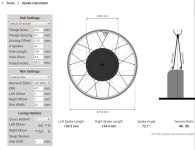Hi, guys.
I had a MXUS xf40 30h motor with a 28" chinese wheel, and figured I would put it to use an try to learn how to build up a wheel on the way. So I ordered a 24" crystalyte rim and some spokes. I have attached the calculator screenshot and a picture of the wheel. I used 135mm 13/14 ga Sapim spokes.
The spot where the spokes meet the nipples does not look good in my eyes. The nipples will not align correctly, and I guess they will break quite soon if I run it like this? I have tightened them to the point they "feel" like my other prebuilt wheels I have on my other bikes, but it does not look right.
Will this be better when I start using the bike, or disaster?
Should I have used a zero cross pattern?
Something else?
I had a MXUS xf40 30h motor with a 28" chinese wheel, and figured I would put it to use an try to learn how to build up a wheel on the way. So I ordered a 24" crystalyte rim and some spokes. I have attached the calculator screenshot and a picture of the wheel. I used 135mm 13/14 ga Sapim spokes.
The spot where the spokes meet the nipples does not look good in my eyes. The nipples will not align correctly, and I guess they will break quite soon if I run it like this? I have tightened them to the point they "feel" like my other prebuilt wheels I have on my other bikes, but it does not look right.
Will this be better when I start using the bike, or disaster?
Should I have used a zero cross pattern?
Something else?





![0708131158-00[1].jpg 0708131158-00[1].jpg](https://endless-sphere.com/sphere/data/attachments/190/190581-a02bcab17f9a8f552a5b2d44cfafbc39.jpg)
![0711131640-00[1].jpg 0711131640-00[1].jpg](https://endless-sphere.com/sphere/data/attachments/190/190582-ad91397716d8b27de62f017d7e936359.jpg)